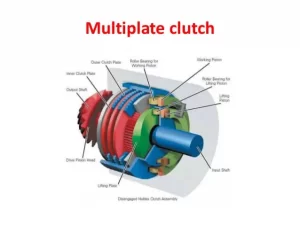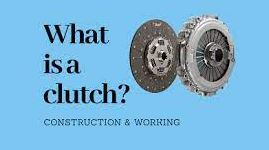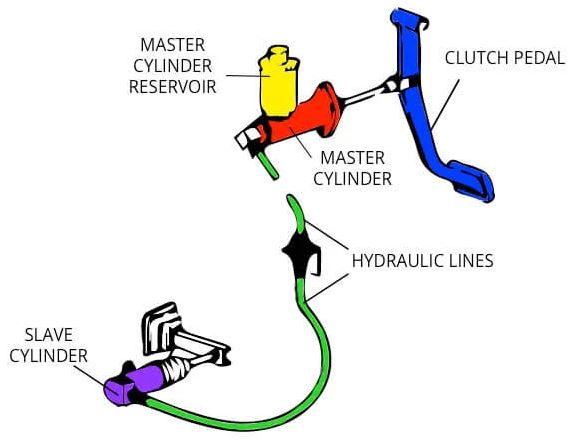What is clutch? Definition | How Clutch Works
Clutch is a device used in the transmission system of a moter vehicle to engage and disengage the Power transmission thuas the clutch is located between the engine and the transmission when the clutch is engaged the power flow from the engine to the rear wheels through the transmission system and the vehicle moves when the clutch is disengaged the power is not transmitted to the rear wheels and the vehicle stop while the engine still running.
Clutch is a mechanical device that connects and disconnects the power transmission between the driving shaft and the driven shaft.
Here the driving shaft is the one that is getting the power from the engine i.e. the engine is rotating and the driven shaft is the one on which the vehicle moves and between these comes the clutch which connects and disconnects these two shafts.
Clutch Material
There are so many materials that have been used for making the clutch plates.
Semi-Metallic Materials: This type of material contains 30% to 65% of steel, iron, and copper. These clutches have high heat resistance and are hard to break and those are durable enough. The plates are reliable but not that good for high-speed operation.
Organic Materials: These are the most common type of materials that we used the most. These materials clutches are capable of all kinds of usage in a variety of vehicles such as size. This material contains high copper content because that it can transfer heat effectively.
Ceramic Materials: These types of clutches contain organic and inorganic materials at the same time which include glass, rubber, Kevlar, and carbon materials. In this clutch, the coefficient of the friction is relatively high which lies between 0.33 to 0.4. In most the intense applications, this type of clutch is used, like in trucks and racing cars.
Characteristic Of Clutch:-
- It Should be capable to transmit maximum torque
- without occurrence of sudden jerk, clutch should be able of engage gradually
- Clutch should be dynamically balanced
- Clutch should have property so tat it damp out the vibration and eliminate the noise
- it should such property that it give good result with minimum effort of the drives
Types of clutch :-
- Friction Clutch – Single Plate Clutch | Multi-Plate Clutch – Wet Clutch & Dry Clutch | Cone Clutch
- Centrifugal clutch
- Semi-centrifugal clutch
- Hydraulic clutch
- Diaphragm clutch
- Vacuum clutch
- Electromagnetic clutch
1) Friction Clutch
The Friction Clutch are three types
- Single plate clutch
- Multi plate Clutch = (1) Wet (2) Dry
- Cone Clutch = (1) External (2) Internal
Single plate clutch
- Single plate clutch :–it is the Most Common types of clutch used in motor Vehicles it consists of only clutch plate the the flywheel is mounted on the engine crank shaft and rotates with it the pressure plate is bolted to the flywheel through clutch spring when the clutch is engaged the clutch plate is gripped between the flywheel and the pressure plate when the clutch pedal is pressed the pressure plate move bake against the force of the spring and the clutch plate become free between the flywheel and the pressure plate.
- Now we will understand “Single Plate Clutch” and its working –
- First of all let us understand about the components of single plate clutch. Which components are used in single plate clutch to do the mechanism and for complete working. Single plate clutch requires many components to complete its function and all these components are mounted in the same correct order. If we go by the name of Single Plate Clutch, then it must be known that in this we use only “One Clutch” plate, which has Friction lining made on both the sides. There are many parts of the engine with the clutch plate which are connected and all these parts help in the working and functioning of the clutch such as – flywheel, pressure plate, bearing, hub, springs, pedal work The pedal shaft has to engage and disengage. Huh. Power transmission in single plate clutch is due to friction which is between two contact surfaces. The Coefficient of Friction of single plate clutch is high and it is also called dry clutch because no lubricant is used in such clutch. Usually the clutch plate is made of steel.
- Pressure Plate – The pressure plate is usually made of cast iron which helps in applying pressure on the clutch plate. So that proper contact can be made between flywheel and clutch plate, with the help of spring.
- Springs – Springs are used to maintain pressure on the pressure plate and also prevent slipping of contact surfaces.
- Flywheel – The flywheel is attached to the engine output and the outer part of it comes into contact with the clutch plate when pressure is applied from the pressure plate.
Working Of Single Plate Clutch
When the engine is running and therefore the flywheel is rotating, the pressure plate also rotates because the pressure plate attaches to the flywheel. The friction disc is located between the flywheel and the pressure plate. When the driving force has pushed down the clutch is released. The pressure plate is bolted to the flywheel through clutch springs and is free to slide (Move) on the clutch shaft when the clutch pedal is operated (Engage and Disengage).
- The working of single plate clutch is quite simple to understand. In this we can easily engage and disengage the torque transmission shafts of the automobile by applying some force to the paddle.
- There is a Lever which is attached to the Paddle and it transmits the Force from the Paddle. And when we press the paddle, the spring gets compressed, at this time the engine which is able to move easily without any load.
- The lever is connected in such a way that when we depress the clutch paddle the thrust bearing moves forward and the pressure plate moves backward and it moves away from the flywheel. In this, the connection between the clutch plate and the flywheel breaks down and the shaft disengages, at this time we can easily change the gears in the automobile.
- Now if we want to connect the shaft again, then we just leave the paddle that is. After this, the springs that remain attached to the pressure plate push the pressure plate forward, so that the shafts are reconnected.
- The clutch plate is mounted on the hub between the pressure plate and the flywheel. Friction lining is maintained on both the sides of the clutch plate and it helps in torque transmission. This was the working of single clutch plate if you want to know it in detail then write in comment
Multi plate:-
- Some of the main components of multi plate clutch are like – Separator plates, pressure plates, diaphragm spring, flywheel, input shaft etc

- Multi plate Clutch consists of a number of clutch plates. as the number of clutch plates are increased the friction surface also increase and increase the capacity of the clutch to transmit torque. the plates are alternately fitted to the engine shaft and gear box shaft when the clutch padal pressed the pressure plate move bake against the force of the spring the clutch plate free between the flywheel and the pressure plate and the power not transmitted to gear box. the multi plate clutches may be dry or wet when the clutch is operated in an oil bath it is called a wet clutch when the clutch is operated dry it is called dry clutch
There are three types of multi plate clutch. –
- Spring Type Multi Plate Clutch
- Diaphragm type Multi Plate Clutch
- Hydraulic operated and automatic clutch.
Multi Plate Clutch Torque enhances the transmission efficiency of the vehicle.
Cone Clutch:-

- these clutch consists of contact surface in the from of cone in it there are two cone internal cone and external cone. frictional living of wire and a setups composition are used for fitting in an internal cone to hold the cone together in position large and strong coil is used torque is transmitted from engine to the fly wheel and internal cone to splined the gear box shaft when clutch is engaged a fast operated paddle or a lever system is employed to pill out the internal cone and over come surface or disconnection of drive friction material is provided in both inner and out side surface of cone.
2)Centrifugal Clutch
For engaging clutches, the Centrifugal clutch uses the concept of centrifugal force. It is operated automatically according to the speed of an engine. Thus, in a vehicle, any clutch paddle is not required for the movement of the clutch.
Working Principle Of Centrifugal Clutch
- This clutch includes a weight that is pivoted in a specific location. According to engine speed centrifugal force moving up the weight and it applies force on the bell crank. Due to this, the plate is pressed.
- After that, the plate presses spring, which is the spring that mainly used to press the clutch plate.
- Now the clutch has become engaged.
- The clutch remains to disengage up to a lower RPM that is near about 500rpm. Lastly, the weights’ movement is controlled by Stop (H).

Advantages Of Centrifugal Clutch
These are the advantages of Centrifugal Clutch:
-
- It is automatic.
- Low cost and also low maintenance cost.
- Less wear and tear.
- Greater control over speed.
3) Semi-Centrifugal Clutch
For keeping in the engaged position, the semi-centrifugal clutch uses spring force along with the centrifugal force. Semi-Centrifugal Clutch is made of a Clutch plate, Friction lining, Levers, Pressure plate, Flywheel, and Clutch springs.
Working Principle Of Semi-Centrifugal Clutch
- Clutch spring and levers fix upon the pressure plate equally. At a normal speed of an engine, the clutch is designed to send torque spring.
- At a normal speed and low power transmission, there is no pressure on the pressure plate. Hence, a clutch remains engaged.
- At a high speed and high-power transmission, there is exert pressure on the pressure plate and the clutch has become engaged.
- Less stiff springs of the clutches help to get rid of any strain for clutch operations.
- When the speed of the vehicle decreases or the speed fell rapidly, there is no pressure on the pressure plate by levers.
4) Diaphragm Clutch
For engaging clutches, this type of clutch generates pressure on the pressure plate. This clutch is made of a diaphragm on the conical spring. The crown or finger-type spring is attached to the pressure plate.
Working Principle Of Diaphragm Clutch
- For the Diaphragm Clutch, engine power is sent to the flywheel from the crankshaft.
- The flywheel consists of friction lining, and the clutch is connected with the flywheel.
- As the pressure is applied to the pressure plate of the clutch, due to which, the clutch plate is located behind the pressure plate.
- The diaphragm clutch is conical in shape. The outside bearing goes to the flywheel after pressing the clutch pedal of the clutch.
- The outside bearing presses the Diaphragm spring. So that the pressure plate is pushed backward by the Diaphragm spring.
- That pressure disengaged the clutch by removing the pressure on the plate.
- The Diaphragm spring and pressure plate came back to the normal state after releasing the pressure from clutch peddles.
5) Electromagnetic Clutch
The electromagnetic clutch is made of things that are applied in electrical engineering.

Those are as follows:
- Rotor: Rotor is the part that connects directly to the engine shaft and helps to rotate the engine shaft and the driving shaft continuously.
- Winding: Winding is attached behind the Rotor. It does not rotate. It is connected with the high voltage DC supply which is converted into the electromagnet by winding.
- Armature: Armature is attached at the front of the rotor. It is attached to the hub by bolts or rivets.
- Hub: Hub is attached behind the Armature. It is attached to the driven shaft by the bolts and rotates with the shaft.
- Friction Plate: Base on the transmission of the power friction plate insertion between rotor and armature is done.
- Supply Unit: Supply unit consists of a battery, clutch switch, wire, etc.
Working Principle Of Electromagnetic Clutch
- High Voltage DC supply is supplied to the Winding from dynamo or battery.
- Winding produces an electromagnetic field that allures the pressure plate and engages the clutch.
- For disengaging, the supply should be disconnected.
- For reliving the switch of the clutch gear lever is made, therefore the clutch is disengaged by changing the gear by driver holds.
- The Clutch is not engaged when the output is low of the dynamo at the low speed.
- There are three springs on the pressure plate to engage the clutch at the low speed also.
6) Vacuum Clutch
The vacuum clutch works through a vacuum. So, its name is Vacuum clutch.

It consists of such parts. Those are:
- Switch
- Non-return valve
- Solenoid
- Piston
- Vacuum Reservoir
- Vacuum Cylinder
- Battery
- Inlet and Outlet
- vacuum clutch diagram
Working Principle Of Vacuum Clutch
- There is an existing vacuum in the engine manifold (Inlet) that operates the Vacuum clutch.
- The engine manifold is attached through a valve which is non-returnable with the Vacuum reservoir.
- The reservoir is attached through a valve that is solenoid-operated with the Vacuum cylinder.
- There is a switch in the gear lever.
- The battery operates the solenoid.
- The lever changes the gear when it is held by the driver and the operation of the switch is done.
- The pressure increases in the inlet manifold when open the throttle. So that the non-return valve is closed, the manifold isolates the reservoir. There is a vacuum present all the time in a reservoir.
Advantages Of Vacuum Clutch
- It is far cheaper than other clutches.
- It allows minimum travel of the actuator.
- Disadvantages of vacuum clutch:
- It consists of multiple components.
- Sometimes sluggishness is found by engineers in a machine.
7) Hydraulic Clutch
The working principle of vacuum and the hydraulic clutch is almost the same.
Although the significant difference between those is that, the hydraulic clutch operates through the pressure of oil, on the other hand, a vacuum clutch operates through a vacuum
Working Principle Of Hydraulic Clutch
Oil is pumped to the accumulator from the reservoir through a pump by an engineer. The connection between the accumulator and cylinder takes place by a control valve.
The engine of the vehicle operates the pump. A switch controls the valve. Apart from that, a linkage mechanism is used by engineers to establish the connection between piston and clutch.
The driver of a vehicle presses the gear lever of the vehicle and opens the switch to the valve to enable the oil flow. Due to the pressure of oil, the piston of the vehicle starts moving forward and backward that leads the clutch is engaging and disengaging.
FAQs.
What is Clutch?
A clutch is a mechanical device that switches the power transmission on and off, in particular from a drive shaft (drive shaft) to a driven shaft. The clutch acts as a mechanical connection between the engine and the transmission. And briefly disconnects or separates the engine from the drive train and thus from the drive wheels when the pedal is depressed, allowing the driver to shift gears smoothly.
What is Clutch in Car?
If you’ve ever driven a manual shift car, then you’re probably familiar with the clutch. It’s the third pedal that you have to press in order to change gears. This is where the clutch comes into play. It can disengage the wheels without killing the engine.
What are the types of Clutch?
Following are the different types of clutch:
1. Friction Clutch – Single Plate Clutch | Multi-Plate Clutch – Wet Clutch & Dry Clutch | Cone Clutch
2. Centrifugal clutch
3. Semi-centrifugal clutch
4. Hydraulic clutch
5. Conical spring clutch or Diaphragm clutch
6. Positive clutch or Dog and Spline Clutch
7. Vacuum clutch
8. Electromagnetic clutch





[…] What is clutch? Definition | How Clutch Works | Clutch PDF […]
[…] What is clutch? Definition | How Clutch Works | Clutch PDF […]